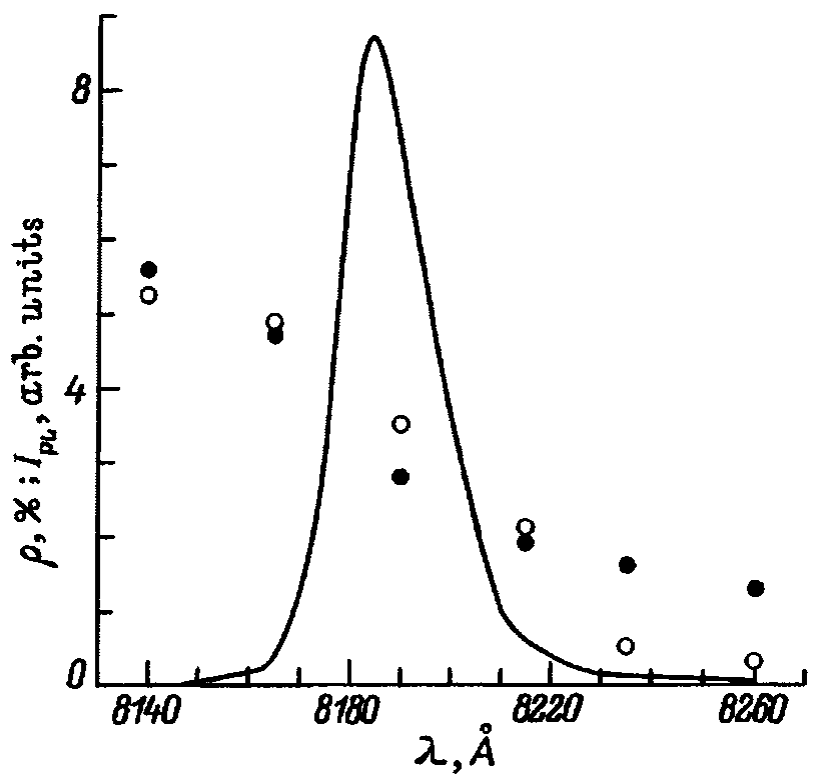An experimental and theoretical study of spin transport in the n-GaAs semiconductor is reported. Transport of average electron spin from the photoexcited crystal surface is shown to be determined by the spin diffusion process. At the same time the transport of photoexcited carriers takes place primarily through photon entrainment, which transfers nonequilibrium carriers into the bulk of the semiconductor to distances considerably in excess of the electron spin diffusion length. A comparison of the experimental results with theory permits one to determine the average-spin diffusion length and electron-spin relaxation time.
Investigation of spin transport in ferromagnetsemiconductor hybrid systems has become a topical problemin recent years.' A study of polarized electron tunneling froma ferromagnet into gallium arsenide was reported.2 The re.verse problem of spin-dependent transport of optically oriented electrons from GaAs into a ferromagnet is also beinginvestigated.3 The effect of stray fields in a demagnetizedferromagnetic film on electron spin polarization in a semiconductor was analyzed in the Ni/n-GaAs system.4 In thelatter work, the interpretation of results depended criticallyon the relation between the domain size A in the film and thespin diffusion length L, of the semiconductor electrons. IfA>Ls, the electron spin undergoes effective relaxation inthe domain magnetic fields. In the opposite case (A<L) thestray magnetic fields of the film decay rapidly near the surface, and there is no spin relaxation of the semiconductorelectrons. In either of the above experiments one has to knowthe electron spin transport in the semiconductor, ie. the effect of photon recycling, spin diffusion, and relaxation on theelectron polarization. This work deals with an experimentaand theoretical investigation of spin transport in the n-GaAssemiconductor (spin transport in p-GaAs was considered inRef. 5). It is shown that the transport of average electron spinfrom a photoexcited crystal surface is dominated by spindiffusion. At the same time photoexcited carriers are trans-ported primarily through photon entrainment, which transfersnonequilibrium carriers into the bulk of the semiconductor todistances considerably in excess of the electron-spin diffusion length. By comparing experiment with theory one candetermine the average-spin diffusion length and the electronspin relaxation time.
The optical orientation experiments were carried out onan n-type GaAs sample (Si concentration 1X 1015 cm-3grown along [001] by liquid-phase epitaxy (layer thickness35 um) on a 400 um-thick gallium arsenide substrate (Siconcentration 1018cm-3). The sample was maintained in aexcited by a Kr+ laserliquid-helium cryostat and(hv= 1.65 eV,= 5 mW, spot diameter d= 300 um), witha photoelastic quartz modulator used to alternate the circularpolarization sign at a frequency of 26.61 kHz. This permittedus to avoid the effect of polarization of the lattice nuclei onthe optical electron orientation The recombination radiationpolarization was measured in reflection by a circular polar-ization analyzer (a quarter-wave phase plate with a linearpolarizer). The desired regions of the luminescence bandcould be cut out with a double-grating spectrometer with a16 A/mm dispersion. The electronic circuit performed syn-chronous counting ofleft- and right-hand circularly polarizedphotons (N~ and N+). The degree of circular polarizationwas found as p=(N+ -N-)/(N+ + N-).
We measured the dependence of p on magnetic fieldperpendicular to the exciting beam, as well as on the wave-length 入 of recombination radiation. Figure l presents spec-tra of luminescence Ip! (solid curve) and of the degree ofcircular polarization (filled circles) obtained in zero magneticfield. If recombination occurred only close to the surface, pwould remain constant throughout the spectral region cov-ered. The noticeable decrease of p in the long-wavelengthwing of the luminescence line indicates that the fraction ofcarriers recombining in the bulk of the crystal is fairly large.This becomes possible if one assumes the presence of photonentrainment which makes nonequilibrium carriers penetrateinto the semiconductor bulk (the diffusion length of nonequilibrium carriers in an n-type semiconductor is determined bythe diffusion length of holes and is extremely short becauseof their low mobility). It should be added that the lumines-cence magnetic depolarization curves have essentially differ.ent shape in the short- and long-wavelength wings of theline. Figure 2a shows the Hanle effect at the shortwavelength edge, and Fig. 2b, at the long-wavelength edgeof the line. The curves in Figs. 2a and 2b are substantially different in shape. The absolute measurement errors for p(>(filled circles in Fig. 1) and p( B) (filled and open triangles inFig. 2) do not exceed 0.06%.

A theoretical analysis of electron spin diffusion inn-GaAs was made in Ref 8 without inclusion of photonentrainment. It was shown that since the region involved inredistribution of excess carriers is dominated by the shorthole-diffusion length, all of the photoluminescence (PL) oc-curs near the semiconductor surface, and that the degree p ofPL circular polarization is determined only by the electronspin density S(0) at the surface. In this case p should notdepend on the wavelength > at which the radiation is de-tected. The shape of the radiation depolarization curve intransverse magnetic field B differs from a Lorentzian. This isa result of the fact that electrons lose their original orientation because of spin diffusion into the bulk of the semicon-ductor, while the spatial distribution of spin density is itself dependent on magnetic field. As follows from our experiments (see Figs.l and 2), however, both p and the shape ofthe Hanle curve depend on the wavelength at which the radiation is detected.
上一篇: 磷化铟衬底的晶体生长和晶片加工
下一篇: 纳米压印光刻技术